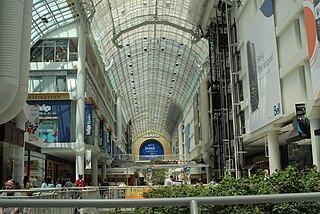
A shopping center, shopping centre, also called a shopping complex, shopping arcade, shopping plaza or galleria, is a group of shops built together, sometimes under one roof.

Scottsdale Fashion Square is an upscale luxury shopping mall located in the downtown area of Scottsdale, Arizona, United States. It is the largest shopping mall in the state, with approximately 2 million square feet (190,000 m2) of retail space, and is among the top 30 largest malls in the country. The mall features Macy's, Dick's Sporting Goods, Dillard's, Nordstrom and Neiman Marcus, in addition to a 14-screen Harkins Theatres.
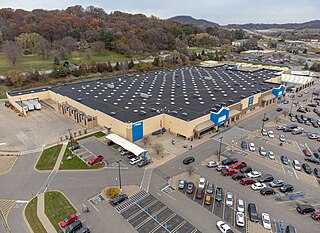
A big-box store is a physically large retail establishment, usually part of a chain of stores. The term sometimes also refers, by extension, to the company that operates the store. The term "big-box" references the typical appearance of buildings occupied by such stores.
Hypermart USA was a demonstrator project operated by Walmart in the 1980s and 1990s, which attempted to combine groceries and general merchandise under one roof at a substantial discount. The hypermart concept was modeled after earlier efforts from other retailers, notably French retailers such as Auchan and Carrefour, and the Midwestern big retailer Meijer. At its peak, Hypermart USA had four locations with two located in Texas, one in Kansas, and one in Missouri.

A retail park is a type of shopping centre found on the fringes of most large towns and cities in the United Kingdom and other European countries. They form a key aspect of European retail geographies, alongside indoor shopping centres, standalone stores like hypermarkets and more traditional high streets.
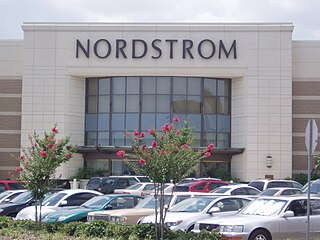
In US retail, an "anchor tenant", sometimes called an "anchor store", "draw tenant", or "key tenant", is a considerably larger tenant in a shopping mall, often a department store or retail chain. They are typically located at the ends of malls, sometimes in the middle. With their broad appeal, they are intended to attract a significant cross-section of the shopping public to the center. They are often offered steep discounts on rent in exchange for signing long-term leases in order to provide steady cash flows for the mall owners. Some examples of anchor stores in the United States are: Macy's, Sears, JCPenney, Nordstrom, Neiman Marcus, Saks Fifth Avenue, Dillard's, Kohl's, and Target. And in Canada; Hudson's Bay, Sears (formerly), Target (formerly), Zellers, Nordstrom/Nordstrom Rack (formerly), TJX Companies, Saks Fifth Avenue, Sporting Life.
Bay Plaza Shopping Center is a shopping center on the south side of Co-op City in the Bronx, New York City. In addition to various department stores and shops, such as Macy's, JCPenney, Staples, and Old Navy, it has a multiplex movie theater, several restaurants, a fitness club, and some office space. Constructed from 1987 to 1988 by Prestige Properties, the shopping center is located between Bartow and Baychester Avenues, just outside Sections 4 and 5 of Co-op City, on an open lot that was the site of the Freedomland U.S.A. amusement park between 1960 and 1964. The Bay Plaza Shopping Center is the largest shopping center in New York City. Since opening over 25 years ago, it has become extremely successful, the center claims to hold some of the highest performing stores on a per-square-foot basis for many national retailers.

Marlborough Mall is a shopping mall located in Calgary, Alberta, Canada. Opened in November 1971, the mall has expanded several times and today includes approximately 100 stores and services, and encompasses 570,837 square feet (53,032.5 m2) of retail floor space. The mall also featured a Safeway until the 1990s, when the store moved to its own location west of 36th Street.
Plaza West Covina is a large regional shopping mall in West Covina, California, owned by the Starwood Capital Group. Its anchor stores are Macy's, JCPenney, XXI Forever, Nordstrom Rack, Best Buy, and Gold's Gym with one vacant space last occupied by Sears. Westfield America, Inc., a precursor to Westfield Group, acquired the shopping center in 1998 and renamed it "Westfield Shoppingtown West Covina", dropping the "Shoppingtown" name in June 2005. In October 2013, the Westfield Group sold the mall to Starwood Capital Group and the mall is now managed by Pacific Retail Capital Partners.
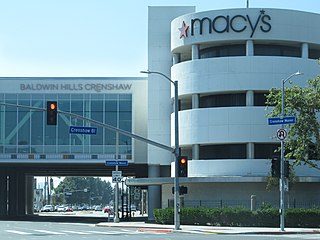
Baldwin Hills Crenshaw Plaza is a shopping mall located in the Baldwin Hills neighborhood of Los Angeles, California. This was one of the first regional shopping centers in the United States built specifically for the automobile. Two anchor buildings, completed in 1947, retain their original Streamline Moderne style. Since the mid-1960s, the mall has become a major economic and cultural hub of surrounding African American communities which include a spectrum of socioeconomic classes.
Florin Towne Centre is an outdoor shopping center in the unincorporated area of Parkway-South Sacramento in Sacramento County, California, United States, in the Sacramento area. It opened in 2008 on the site of the old Florin Mall, which closed and was demolished in 2006. The 484,500 square feet (45,010 m2) center is anchored by AutoZone, Chuze Fitness, PetSmart, US Foods CHEF'STORE, and Walmart Supercenter.
This is a list of small shopping centres in the island of Montreal.
Anaheim Plaza, originally Broadway Orange County Center, then Anaheim Center, in Anaheim, California, was the first shopping mall in Orange County. It was a regional mall from 1955 to 1993 and is now a power center anchored by big-box stores.

A power center or big-box center is a shopping center with typically 250,000 to 600,000 square feet of gross leasable area that usually contains three or more big box anchor tenants and various smaller retailers, where the anchors occupy 75–90% of the total area.
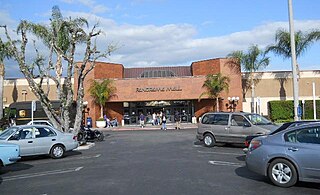
Panorama Mall is a mall in Panorama City, San Fernando Valley, Los Angeles, California. It is an enclosed mall anchored by two large discount stores, Walmart and Curacao, aimed primarily at a Hispanic customer base.

A neighborhood shopping center is an industry term in the United States for a shopping center with 30,000 to 125,000 square feet of gross leasable area, typically anchored by a supermarket and/or large drugstore.

Orange County Plaza, later Garden Grove Mall, Garden Promenade, now The Promenade at Garden Grove, was, upon its expansion in 1959, with sixty stores, the largest shopping center in Orange County, California, and at the time billed itself as "Orange County's first regional shopping center". However, Anaheim Plaza had in fact already opened In 1955, four years prior, and had an anchor department store.

Retail in Southern California dates back to its first dry goods store that Jonathan Temple opened in 1827 on Calle Principal, when Los Angeles was still a Mexican village. After the American conquest, as the pueblo grew into a small town surpassing 4,000 population in 1860, dry goods stores continued to open, including the forerunners of what would be local chains. Larger retailers moved progressively further south to the 1880s-1890s Central Business District, which was later razed to become the Civic Center. Starting in the mid-1890s, major stores moved ever southward, first onto Broadway around 3rd, then starting in 1905 to Broadway between 4th and 9th, then starting in 1915 westward onto West Seventh Street up to Figueroa. For half a century Broadway and Seventh streets together formed one of America's largest and busiest downtown shopping districts.
The retail format influences the consumer's store choice and addresses the consumer's expectations. At its most basic level, a retail format is a simple marketplace, that is; a location where goods and services are exchanged. In some parts of the world, the retail sector is still dominated by small family-run stores, but large retail chains are increasingly dominating the sector, because they can exert considerable buying power and pass on the savings in the form of lower prices. Many of these large retail chains also produce their own private labels which compete alongside manufacturer brands. Considerable consolidation of retail stores has changed the retail landscape, transferring power away from wholesalers and into the hands of the large retail chains.
Country Club Centre is a shopping center in the Arden-Arcade area in unincorporated Sacramento County, California, United States, in the Sacramento area. It is located at the southwest corner of El Camino and Watt Avenues, diagonally across from what was the first stand-alone store of the now defunct Tower Records chain. It originally opened as a small strip shopping center in 1952 that was later expanded into a regional mall and then later converted into a mixed use of office and retail. The shopping center is currently anchored by the Sacramento area’s only Costco Business Center. It was previously anchored by Walmart (closed), Sam's Club and Michaels (relocated).














